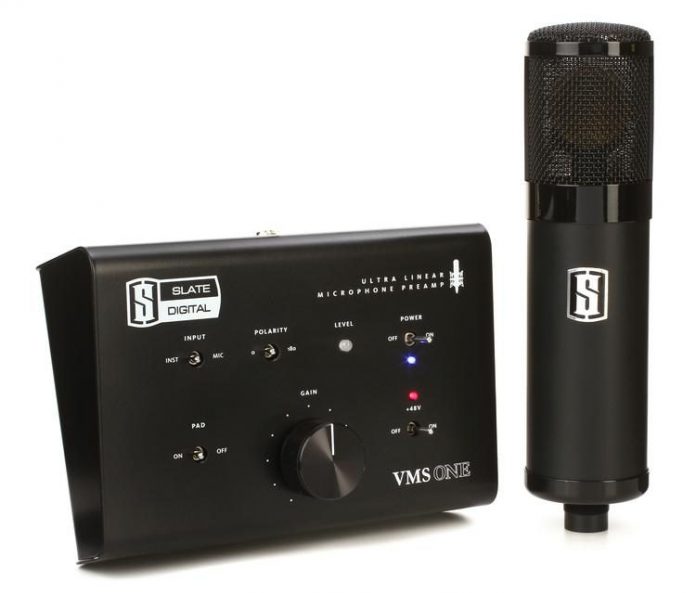If you hadn’t figured it out already, I’m a bit of a Slate fangirl, so it’s no wonder that when they came out with their virtual microphone system I was quick to buy it. I mean, one relatively cheap microphone that I can make sound like a ton of expensive microphones? Of course I’m going to want that!
Here’s the thing about audio education: you learn on the wrong gear. You go to school, and they have a mic locker larger than any studio, with tons of every type of microphone you can imagine, which is great for learning the intricacies of different mics and micing techniques and prepping you for the next phase of your education: your internship! So you intern in a fancy studio and they too have fancy mic after fancy mic, and you learn the sound of the classics. The U47s, the U67s, the 251s and C12s. You know how to pair them to different sources, different voices, and start conceptualizing your songs in terms of these mics, as well as the other studio workhorses you’ve learned on. But then, you go out into the real world and start building your discography and realize that the bands you’re working with can’t even dream of affording to work in the places that have the gear with which you learned to record.
It’s this reason that made me so excited when Slate released the ML-1 system. I was already familiar with their preamp emulations thanks to the All Access Pass, which definitely gave me that vibe I was after, so I was sure their mic models would perform the same. At the time you could only buy the mic bundled with their giant preamp, as the system is technically designed to work with both. It arrived and…. didn’t work. I contacted support who were kind enough to quickly ship off a replacement. As with all product launches, there are some hiccoughs, and I guess the power supply for the preamp is one of them. But, I got a working one and set it up and loaded up the signal chain (U47 -> 1073 -> Neve channel, because duh, I’m a Neve girl).
I’m going to start with the preamp. A mic is a mic. You plug it in, turn on phantom power, adjust your preamp gain, and there you go. The preamp that came with the unit is clunky. Huge, with an equally huge power supply. Does the system come with a flight case large enough to put it all in there like you get with tube mics? Of course not. So now I’ve got to put everything in a backpack to lug it around. The switches are flimsy and feel like they’re gonna break, so boo to that too. The gain knob, like far too many gain knobs, goes from too low to too high if you look at it funny, so it takes a delicate touch to set the input just right. Pains, to be sure. So why lug around the preamp when you could just use any other preamp with the mic? After all, they decided to stop bundling the two together because you get good results with any transparent pre. Because it sounds good!
Or, more specifically, it sounds transparent. Really transparent. The raw signal has a nice warmth to it, and a three dimensionality you don’t get from most microphones. It’s so transparent that it’s eerie, to the point where you actually want to add some color and vibe to it so that it stops sounding so weird. So modern. We’re used to vibey gear. So much of our software is aimed at recreating that vibe. That doesn’t mean it’s not usable. I actually used the raw mic on “Revolution Lover” by Left at London, though still ran the vocals through an LA2A -> 1176 -> Pultec to vibe it up (I love when I can use actual fancy gear, so rare these days). All that transparency is there for a reason, though. When you do actually load up the software, you get exactly what you pay for. Every mic I tried I was hit with that familiarity that I was hoping for. My thoughts were “Yep, that sounds like a 47 alright. Yep, that sounds like a 251.” But, it was when I started using it on projects that the real power of the system was able to shine.
It’s one thing to have the sound of tens of thousands of pieces of expensive gear for about $1k, but doing it with software gives you a flexibility you could only dream of. Because I don’t have to spend the studio time setting up a few microphones, doing a blind shootout, picking the best one, getting that one sounding all pretty, and finally having the artist do their takes. I can switch through the mics in a second, and tweak the EQ as needed without making previous takes useless. What’s more, I can change the mics during the mix if I decide one fits a performance better, and if I’m doing doubles or background vocals or an impromptu acoustic guitar, I can switch around the mics to create the separation and premix the track, either live (the software is supposedly latency free) or in the mix. This saves studio time, which saves money, and opens up a whole mess of creativity down the line. You can even use the software on sources not recorded with the mics! It won’t sound as accurate, since the software is designed to pair with the frequency response of the mic, but it’s still going to give you that flavor. Many times I’ve felt that something needs to be a bit more C12ish, and with this system I can do just that. There are even expansion packs that add more microphones, both new models as well as different versions of ones already available. How wonderful is it to be able to choose between three U47s, just like if you were at the top studios in the world?
Not too long ago, Slate introduced the ML-2 microphones. The ML-2s are small diaphragm condensers, super cheap, and designed to recreate the sound of your studio workhorses. Your SM57s, C414s, 121s, 421s, and many others. Again, this fills the need of having access to the mics and tones you get with larger budgets, and keeps you working with the variety you learned with. As with the ML-1 emulations, the ML-2 ones sound like what you want them to sound like. Are they as good as the real deal? I dunno. Comparisons released by the company show there’s a difference in their sound, but that the character is there, and that difference is within the spectrum of what you’d find between any two pieces of the actual mics. If I had to choose, naturally, I’d go for the real thing, because why not? But I can’t really justify getting a pair of 121s. I can justify getting a pair of ML-2s. Or the dozen or so I’d get for the same price. Imagine what you could do with a dozen mics. You could almost mic up a drum kit! And do things you wouldn’t even dream of doing with the real deals.
Right now my ML-2s are on loan to an artist. We’re doing the distance producing thing, and in the past I’ve found his songs very difficult to get a handle on. He was recording them with a single mic, and not one that was very conductive for having a ton of layers added together, like his style requires. By getting him to use the ML-2s, I now can choose the mics like I would if we were in a studio, and get him sounding the same. I’m immensely happy being able to pair a 57 with a 121 on a guitar cab with only a single mic, use 414s on an acoustic guitar, and 451s on overheads. It makes my job easier, so I can focus on the creativity rather than struggling to make everything sound decent, and it makes the results better.
The one major drawback of both mics is that they’re only cardioid. Now, most of the time you’re going to be using a cardioid polar pattern, so it doesn’t matter too much, but I do find myself wanting other patterns from time to time (like when I want to use my beloved Blumlein), meaning I still need multi-pattern mics. It also makes the ribbons sound weird. They kind of fake the figure eight, but it’s not the same. It’s fine in the context of a mix, but falls short when it comes to accurately recreating the sound of the mic (even though the 121 model sounds amazing, just like all the other models). Does that matter? Not really, aside from not being able to do certain mic techniques. Do I want Slate to release a deluxe version that’s multi-pattern, like other modeling mics? Yes. Yes please. I want to stay in the ecosystem while being able to push my creativity as far as I can. Gimme polar patterns!
So, should you buy? Yes. Even if you have the fanciest mics, the flexibility and convenience is worth the price alone. If you don’t have the fanciest mics, well then it’s obvious. Do you want to sound like you recorded in the top studios? Do you want the familiarity with the gear for when you are able to record at the top studios? Do you want to be able to adjust your mic choice in the mix? Save time choosing mics during recording (or not even having to choose at all)? Do you want a Royer 121 for $150? Then buy the mics.
And if you do choose to buy the mics, please use our affiliate links. This will help us continue to run the site and bring you more sassy content!
Slate ML-1 (the large diaphragm tube modeling mic)
Slate ML-2 (the small diaphragm workhorse modeling mic)

Lilian Blair is a producer, engineer, and audio educator in the Seattle area. She specializes in studio recording, mixing, and helping artist achieve their musical dreams.


